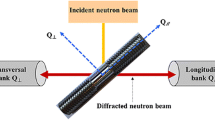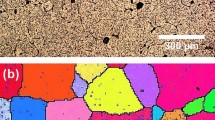Abstract
A numerical method for the generation of the microstructure of a binary aluminum copper alloy is presented. This method is based on the repeated addition of some basic grain shapes into a representative volume element. Depending of the orientation of adjacent grains, different type of grain boundaries can be formed. The primary and secondary phases are distinguishable in our model and have distinct properties, reflecting the heterogeneous nature of the microstructure. The digital microstructure was then transformed into a finite element model. Using the finite element software ABAQUS, the stress distribution inside our heterogeneous material model has been studied and its mechanical properties have been found. That also makes possible to study and to visualize the cracks generated during the loading of the material where the local stress was sufficiently high. As a result of these analyses, the elastic modulus of such a heterogeneous domain and the effect of crack formation on ductility were evaluated.












Similar content being viewed by others
References
R. Phillips, Current Opinion in Solid State & Materials Science, 1998, vol. 3 (6), pp. 526-532.
D. Raabe, Computational materials science: the simulation of materials microstructures and properties, 1st ed., p. 233, Wiley-VCH, New York, 1998.
K. W. Mahin, K. Hanson, and J. W. Jr. Morris, Acta Metall., 1980, vol. 28, pp. 443-453.
H.J. Frost, J. Whang, and C.V. Thompson: in Proc. 7th RISØ International Symposium on Materials Science, N. Hansen, D. Juul Jensen, T Leffers, and B. Ralph, eds., RJSØ National Laboratory, Roskilde, 1986, p. 315.
F. J. Humphreys, Acta Materialia, 1997, Vol. 45 (10), pp. 4231-4240.
F. J. Humphreys, Acta Materialia, 1997, Vol. 45 (12), pp. 5031-5039.
D. Juul Jensen, Scripta Metall. Mater., 1992, vol. 27, pp. 1551-56.
D. Juul Jensen,. Met. Mater. Trans. A, 1997, vol. 28, pp.15-25.
Y.Z. Wang and L.Q. Chen: Simulation of Microstructure Evolution, Methods in Materials Research, E.N. Kaufmann, R. Abbaschian, A. Bocarsly, et al., eds., Wiley, New York, NY, 1999.
L. Madej L. Rauch, K. Perzynski, P. Cybulka, Archives of Civil and Mechanical Engineering, 2011, vol. 11, pp. 661-679.
L. Madej, L. Sieradzki, M. Sitko, K. Perzynski, K. Radwanski, R. Kuziak, Computational Materials Science, 2013, vol. 77, pp. 172-181.
M. Ortiz, R. Phillips, Adv. Appl. Mech. 1998, vol. 36, pp. 1-79.
P. R. Dawson, E. B. Marin, Adv. Appl. Mech. 1998, vol. 34, pp. 77-169.
A. J. Beaudoin, H. Mecking, U. F. Kocks, Philos. Mag. A, 1996, vol. 73, pp.1503–1517.
R. Becker, Acta Metall., 1991, vol. 39, pp. 1211-1230.
P.E. McHugh, R.J. Asaro, and C.F. Shih, Acta Metall., 1993, vol. 41, pp 1461–76.
W. Kurz, D.J. Fischer, Fundamentals of solidification, 3rd ed., p. 118, Trans Tech, Switzerland, 1992.
D. Larouche, CALPHAD, Vol. 31, 2007, pp. 490-504.
B. Dutta, O. Pompe, M. Rettenmayr, Materials Science & Technology, Vol. 20, 2004, pp. 1011-1018.
J. E. Bresenham, IBM Systems Journal, 1965, vol. 4 (1), pp. 25–30.
G.C. Hasson and C. Goux, Scripta Metall., 1971, vol. 5, pp. 889-894.
V. Mathier, A. Jacot, M. Rappaz, Modelling Simul. Mater. Sci. Eng., 2004, vol. 12, pp. 479–490.
M. Rappaz, A. Jacot, W.J. Boettinger, Metall. Mater. Trans. A, 2003, vol. 34, pp. 467–479.
H. K. Kamga, D. Larouche, M. Bournane, A. Rahem, Inter. Journal of Cast Metals Research, 2012, vol. 25 (1), pp. 15-25.
S. Vernède, M. Rappaz, Acta Materialia, Vol. 55, 2007, pp. 1703-1710.
F. R. Eshelman, J. F. Smith, J. Appl. Phys., 1978, vol. 49, pp. 3283–3288.
D. Levasseur, D. Larouche, Materials Science and Engineering A, 2011, vol. 528, pp. 4413–4421.
M. Kutz, “Handbook of Materials Selection”, John Wiley & Sons, Inc., New York, 2002.
M. Tiryakioglu, J. Campbell, N.D. Alexopoulos, Materials Science and Engineering A, 2009, vol. 506, pp. 23-26.
ABAQUS 6.12 Documentations, ABAQUS Analysis User’s Manual, Section 24.2.2, Dassault Systèmes, 2012.
W. F. Smith, “Foundations of Materials Science and Engineering”, 2nd ed, McGraw‐Hill, Inc., New York, 1993.
Author information
Authors and Affiliations
Corresponding author
Additional information
Manuscript submitted January 24, 2014.
Rights and permissions
About this article
Cite this article
Sharifi, H., Larouche, D. A Numerical Method for Microstructure Generation of a Binary Aluminum Alloy and Study of Its Mechanical Properties Using the Finite Element Method. Metall Mater Trans A 45, 5866–5875 (2014). https://doi.org/10.1007/s11661-014-2446-3
Published:
Issue Date:
DOI: https://doi.org/10.1007/s11661-014-2446-3




